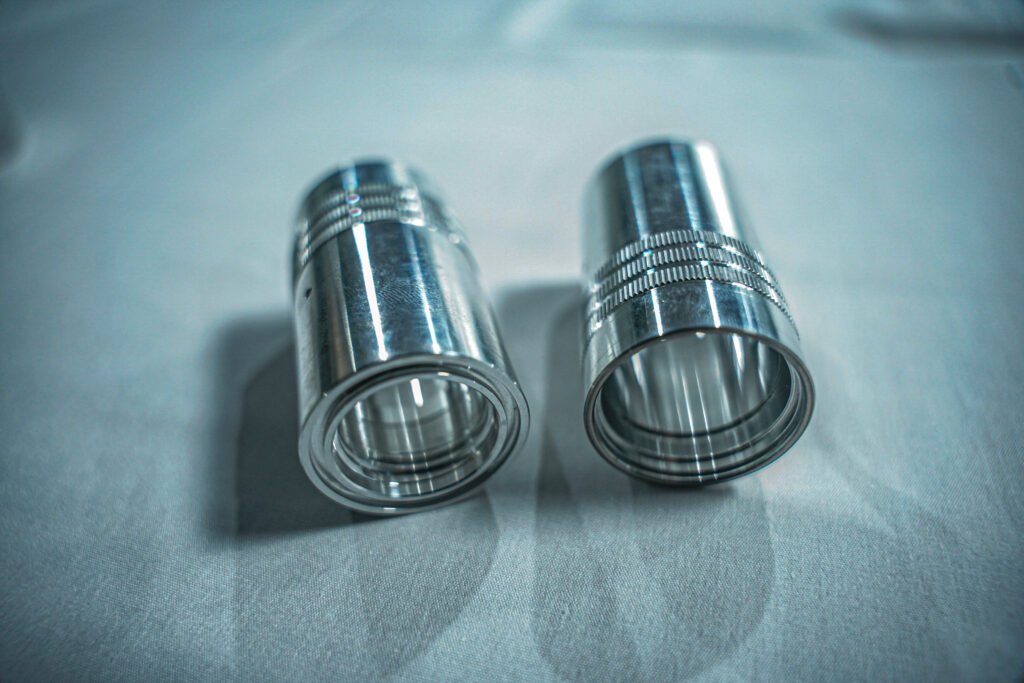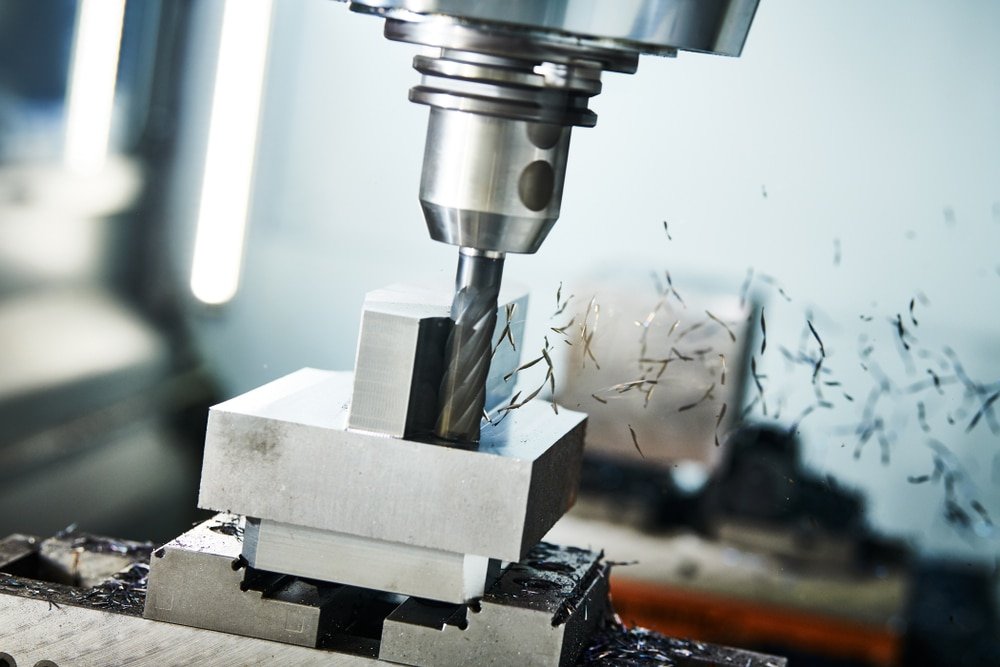Aluminum CNC machining involves using computer numerical control (CNC) machines to precisely cut and shape aluminum into various components and parts. This process is highly efficient and allows for high levels of accuracy, making it ideal for producing intricate designs and complex geometries.
Aluminum’s lightweight, strength, and corrosion resistance make it a popular choice in industries such as aerospace, automotive, and electronics. CNC machining of aluminum ensures high-quality finishes, tight tolerances, and consistent repeatability, making it a preferred method for both prototyping and mass production. In this article, MaTec Vietnam will help you explore Aluminum in CNC Machining industries in detail.
What is Aluminum
Aluminum is one of the most commonly machined materials today, second only to steel in terms of machining frequency. This is primarily due to its excellent machinability. In its purest form, aluminum is a soft, ductile, non-magnetic, silvery-white metal.
It is rarely utilized in its purest form, though. Instead, aluminum is often alloyed with elements like manganese, copper, and magnesium to create hundreds of aluminum alloys, each with significantly enhanced properties.
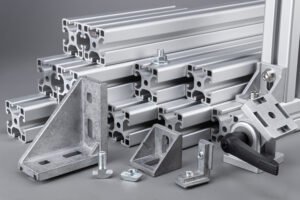
Aluminum’s Advantages for CNC Machined Parts
Although there are numerous aluminum alloys with varying properties, several fundamental characteristics apply to almost all aluminum alloys.
Machinability
Aluminum is easily formed, worked, and machined using various processes. Its softness allows it to be quickly and easily cut by machine tools, and it chips easily, making it less expensive and requiring less power to machine than steel.
These characteristics benefit both the machinist and the customer ordering the part. Additionally, aluminum’s good machinability means it deforms less during machining, leading to higher accuracy and enabling CNC machines to achieve tighter tolerances.
Strength-to-Weight Ratio
Aluminum has about one-third the density of steel, making it relatively lightweight. Aluminum is quite strong while being lightweight. This combination, known as the strength-to-weight ratio, makes aluminum ideal for parts in industries such as automotive and aerospace, where both strength and low weight are crucial.
Corrosion Resistance
Aluminum is resistant to scratching and corrosion in common marine and atmospheric conditions. These properties can be further enhanced by anodizing. It’s important to note that corrosion resistance varies among different aluminum grades, but the most commonly CNC machined grades generally offer excellent resistance.
Performance at Low Temperatures
Many materials lose their desirable properties at sub-zero temperatures; for example, carbon steels and rubber become brittle. In contrast, aluminum retains its softness, ductility, and strength even at very low temperatures.
Electrical Conductivity
Pure aluminum has an electrical conductivity of about 37.7 million siemens per meter at room temperature. While aluminum alloys may have lower conductivities than pure aluminum, they are still conductive enough for use in electrical components.
However, if electrical conductivity is not a desirable characteristic for a machined part, aluminum may not be the best choice.
Recyclability
CNC machining processes generate a significant amount of waste material in the form of chips. Aluminum is highly recyclable, requiring relatively low energy, effort, and cost to recycle. This recyclability is beneficial for reducing material wastage and makes aluminum a more environmentally friendly material to machines.
Anodization Potential
Anodization, a surface finishing process that increases wear and corrosion resistance, is easily achievable with aluminum. This process also simplifies adding color to machined aluminum parts.
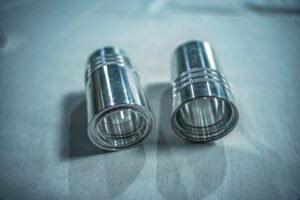
Popular Alloys in Aluminum for CNC Processing
Based on our experience at MaTec Vietnam, the following aluminum grades are among the most frequently used for CNC machining:
EN AW-2007 / 3.1645 / AlCuMgPb
Alternative designations: 3.1645, EN 573-3, AlCu4PbMgMn.
This aluminum alloy contains 4-5% copper as its main alloying element. It is a short-chipped, durable, lightweight alloy with high mechanical properties similar to AW 2030. It is suitable for threading, heat treatment, and high-speed machining, making it ideal for producing machine parts, bolts, rivets, nuts, screws, and threaded bars. However, it has low weldability and corrosion resistance, so protective anodizing is recommended after machining.
EN AW-5083 / 3.3547 / Al-Mg4.5Mn
Alternative designations: 3.3547, Alloy 5083, EN 573-3, UNS A95083, ASTM B209, AlMg4.5Mn0.7.
AW 5083 is known for its excellent performance in harsh environments. It contains magnesium and traces of chromium and manganese, offering high resistance to corrosion in chemical and marine environments. It has the highest strength of all non-heat treatable alloys, retaining this property even after welding. Although it should not be used in temperatures above 65°C, it excels in low-temperature applications, making it suitable for cryogenic equipment, marine applications, pressure equipment, chemical applications, welded constructions, and vehicle bodies.
EN AW-5754 / 3.3535 / Al-Mg3
Alternative designations: 3.3535, Alloy 5754, EN 573-3, UNS A95754, ASTM B209, Al-Mg3.
AW 5754 is a wrought aluminum-magnesium alloy with the highest percentage of aluminum. It may be forged, extruded, and rolled.
It is non-heat treatable but can be cold-worked to increase strength at the cost of ductility. This alloy has excellent corrosion resistance and high strength, making it popular for CNC machining in welded structures, flooring applications, fishing equipment, vehicle bodies, food processing, and rivets.
EN AW-6060 / 3.3206 / Al-MgSi
Alternative designations: 3.3206, ISO 6361, UNS A96060, ASTM B221, AlMgSi0.5.
This magnesium and silicon-containing wrought aluminum alloy is heat-treatable with average strength, good weldability, and good formability. It is highly resistant to corrosion, which can be further improved through anodizing. Construction, food processing, medical equipment, and automobile engineering are among industries that often employ EN AW 6060.
EN AW-7075 / 3.4365 / Al-Zn6MgCu
Alternative designations: 3.4365, UNS A96082, H30, Al-Zn6MgCu.
The main alloying ingredient in this grade is zinc. EN AW 7075 has average machinability, poor cold forming properties, and is unsuitable for welding and soldering. However, it has a high strength-to-density ratio, excellent resistance to atmospheric and marine environments, and strength comparable to some steel alloys. This alloy is used in a wide range of applications, including hang glider and bicycle frames, rock climbing equipment, weaponry, and mold tool manufacturing.
EN AW-6061 / 3.3211 / Al-Mg1SiCu
Alternative designations: 3.3211, UNS A96061, A6061, Al-Mg1SiCu.
Containing magnesium and silicon as its major alloying elements with trace amounts of copper, this high-strength alloy (tensile strength of 180 MPa) is suitable for highly loaded structures such as scaffolds, rail coaches, and machine and aerospace parts.
EN AW-6082 / 3.2315 / Al-Si1Mg
Alternative designations: 3.2315, UNS A96082, A-SGM0.7, Al-Si1Mg.
This medium-strength alloy, typically formed by rolling and extrusion, offers very good weldability and thermal conductivity, along with high stress corrosion cracking resistance. Its tensile strength ranges from 140 to 330 MPa, making it heavily used in offshore construction and container applications.
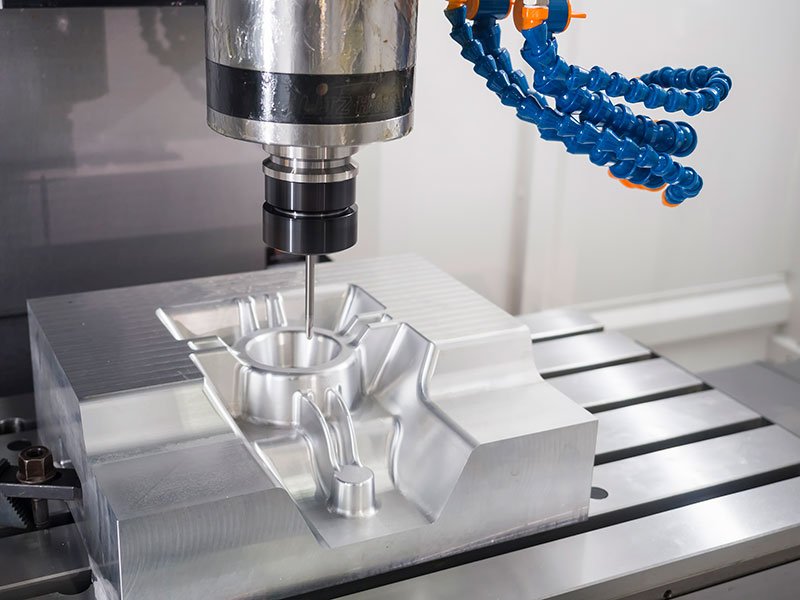
Aluminum CNC Machining Processes
Aluminum can be machined using various CNC machining processes, including:
CNC Turning
In CNC turning, the workpiece rotates while the single-point cutting tool remains stationary along its axis. Depending on the machine, either the workpiece or the cutting tool performs the feed motion against the other to remove material.
CNC Milling
CNC milling is the most common process for machining aluminum parts. It involves the rotation of a multi-point cutting tool along its axis while the workpiece remains stationary along its own axis. Material removal is achieved by the feed motion of either the workpiece, the cutting tool, or both, and can be performed along multiple axes.
Pocketing
Also known as pocket milling, this process involves machining a hollow pocket into a part using CNC milling techniques.
Facing
Facing involves creating a flat cross-sectional area on the surface of a workpiece through either face turning or face milling.
CNC Drilling
CNC drilling creates holes in a workpiece using a multi-point rotating cutting tool of a specific size. The tool moves in a straight line perpendicular to the surface to be drilled, effectively creating a hole.
Post-Machining Processes
After machining an aluminum part, certain processes can be carried out to enhance its physical, mechanical, and aesthetic features. The most common processes include:
Bead and Sand Blasting
Bead blasting is a finishing process aimed at enhancing aesthetics. The machined part is blasted with tiny glass beads using a highly pressurized air gun, effectively removing material and ensuring a smooth surface. This process gives aluminum a satin or matte finish. Key parameters for bead blasting include the size of the glass beads and the air pressure used. Bead blasting should be used only when the dimensional tolerances of the part are not critical. Other finishing processes may include polishing and painting.
Coating
Coating involves applying another material, such as zinc, nickel, or chrome, onto an aluminum part to improve its properties. This can be achieved through electrochemical processes.
Anodizing
Anodizing is an electrochemical process where an aluminum part is immersed in a solution of diluted sulfuric acid, and an electric voltage is applied across the cathode and anode. This process converts the exposed surfaces of the part into a hard, electrically non-reactive aluminum oxide coating. The density and thickness of the coating depend on factors such as the solution’s consistency, anodizing time, and electric current. Anodizing can also be used to add color to a part.
Powder Coating
Powder coating involves applying a polymer powder of various colors onto a part using an electrostatic spray gun. The part is then cured at a temperature of 200°C. Powder coating enhances strength and resistance to wear, corrosion, and impact.
Heat Treatment
Parts made from heat-treatable aluminum alloys may undergo heat treatment to improve their mechanical properties.
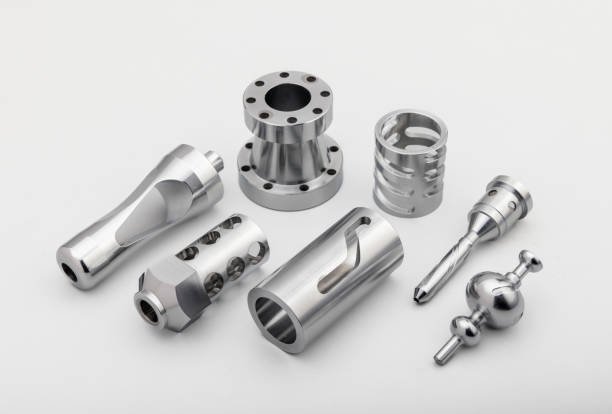
Applications of CNC Machined Aluminum Parts in Industry
As mentioned earlier, aluminum alloys possess numerous desirable properties, making CNC-machined aluminum parts essential in various industries, including:
- Aerospace: Machined aluminum parts are crucial in aerospace due to their high strength-to-weight ratio. Many aircraft fittings are made from aluminum to enhance performance and reduce weight.
- Automotive: Similar to the aerospace industry, aluminum parts find extensive use in automotive applications. Components like shafts benefit from aluminum’s lightweight yet strong properties, contributing to fuel efficiency and vehicle performance.
- Electrical: CNC-machined aluminum parts are commonly employed as electronic components in electrical appliances due to their high electrical conductivity.
- Food/Pharmaceutical: Aluminum parts are vital in the food and pharmaceutical industries because they resist chemical reactions with most organic substances, ensuring safety and integrity in critical applications.
- Sports: Aluminum is a preferred material for manufacturing sports equipment such as baseball bats and sport whistles due to its lightweight, durable, and corrosion-resistant properties.
- Cryogenics: Aluminum’s ability to maintain its mechanical properties at sub-zero temperatures makes it desirable for cryogenic applications, where extreme cold conditions are encountered.
>>> Read more: What Is the Difference between Titanium vs Stainless Steel?
Conclusion
Overall, Aluminum CNC machining offers a plethora of benefits, ranging from its excellent machinability and strength-to-weight ratio to its corrosion resistance and suitability for various industries such as aerospace, automotive, and electronics. With its versatility and reliability, CNC-machined aluminum parts play a crucial role in modern manufacturing processes.
For those seeking high-quality CNC machining services in Vietnam, MaTec Vietnam stands out as a reliable partner. With their expertise, state-of-the-art equipment, and commitment to precision and quality, MaTec Vietnam delivers exceptional results for aluminum CNC machining projects. Whether you’re in need of prototyping or mass production, MaTec Vietnam’s dedication to excellence ensures that your machining needs are met with efficiency and precision.

